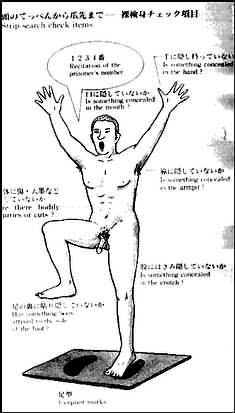PRISONS IN JAPAN
Extracted from PRISONS IN JAPAN, produced by JAPAN FEDERATION OF BAR ASSOCIATIONS (NICHIBENREN) 1992, 1-3, KASUMIGASEKI 1-CHOME CHIYODA-KU, TOKYO 100, JAPAN
It is said that prisons are a barometer of democracy. Japan's defeat in 1945 became a springboard for far-reaching systemic changes according to a new democratic institution. However, to this day Japan's prisons are run according to the prison law of 1908, the product of an age in which the Emperor was sovereign, and administrative directives whose primary intent is disciplinary. More about this in college term papers for sale because no matter what crime a person commits, the prisoner should be punished, not tortured. The focus of Japan's Prison Law is entirely on the authority of the prison officials. There is not a single provision whose intent is to protect the rights of the inmates. Practices in Japanese prisons such as those requiring inmates to request permission to read books or magazines or the system of penalties for rule infractions are out of step with the modern age.
JAPAN'S PRISON SYSTEM
In 1991 the average daily prison population in Japan was 45,749 inmates, including 38,657 sentenced and 6,949 unsentenced inmates and 143 inmates of other status. In 1990, 22,745 convicts were newly imprisoned. The ratio of sentenced inmates to the general population is at a very level compared to Western countries. By far the greatest number of offenses were for acts of theft and use of stimulant drugs.
1. CONVICT'S LIFE: MILITARY MARCHING AND STRIP SEARCHES

This examination requires the completely unclothed prisoner to raise his arms above his head and alternately raise each leg for the guard's inspection. In-cell inspections are held every morning. During the period of the inspection, all convicts are required to remain motionless in their cells in the seiza position (a formal posture of sitting on one's heels, a position that causes numbness of the limbs after a time).
INTRODUCTION
It is said that prisons are a barometer of democracy. Japan's defeat in 1945 became a springboard for far-reaching systemic changes according to a new democratic institution. However, to this day Japan's prisons are run according to the prison law of 1908, the product of an age in which the Emperor was sovereign, and administrative directives whose primary intent is disciplinary. More about this in college term papers for sale because no matter what crime a person commits, the prisoner should be punished, not tortured. The focus of Japan's Prison Law is entirely on the authority of the prison officials. There is not a single provision whose intent is to protect the rights of the inmates. Practices in Japanese prisons such as those requiring inmates to request permission to read books or magazines or the system of penalties for rule infractions are out of step with the modern age.
In 1982, the government embarked upon a process of revising the Prison Law according to a self-declared policy of "codification, modernization and internationalization." A Penal Facility Bill was submitted to the National Diet (parliament). As it stands, the bill is entirely unacceptable. Not only does it perpetuated the present rules and policies presently in force in prisons but has been presented as a single package with a separate Police Detention Facility Bill which perpetuates the infamous daiyo-kangoku, that is police station cells used as "substitute prisons".
It has been demonstrated time and again that daiyo-kangoku is a hotbed for false charges. Japan Federation of Bar Associations (Nichibenren) has steadfastly opposed the two bills. It has set up a special headquarters to coordinate the movement of opposition to these bills. Thus far, the legislation package has been presented unsuccessfully twice to the Diet. In 1991 it was submitted once again, and is still under deliberation. In the past, Nichibenren has promoted adoption of a new prison law that protects the human rights of inmates. Now we have released our own official proposal for such a law, one that meets international standards of human rights. Saber Abe President Japan Federation of Bar Associations (Nichibenren) October 1992
JAPAN'S PRISON SYSTEM
1. LOW SENTENCED PRISONER TO GENERAL POPULATION RATIO
2. RANKING OF SENTENCED PRISONERS
The treatment that a convict receives depends upon his grade. New convicts are designated grade 4. They are promoted step by step to grade 1 according to appraisals of their work records, behaviour, sense of responsibility, etc. Restrictions are relaxed progressively in the higher grades, so that the convict is allowed to purchase more items, receive more visits or send and receive more letters.
3. PREDOMINANCE OF SECURITY PERSONNEL
By the end of 1991, there were 74 main prisons, 117 branch prisons and 9 work-houses, for a total of 200 penal institutions. In 1992 there were 17,024 prison workers, 14,629 or 86% of which were security personnel. This amounts to an over-concentration on security and a fundamental insufficiency of social workers and counsellors.
1. CONVICT'S LIFE: MILITARY MARCHING AND STRIP SEARCHES
The current prison law is lacking in specifics concerning the rights and duties of convicted detainees. For this reason, much is left to the discretion of the prison directors. Following is a generalised description of the life of convicts under the supervision of prison guards. All convicts are strip-searched when they enter the facility. This includes an anal examination, in which a glass rod is inserted into the anus. In the majority of facilities, strip searches are conducted twice daily, when convicts are transferred from the cell to the work-house and then on the way back from the work-house to the cell. The strip search also involves what convicts call "the can-can".
